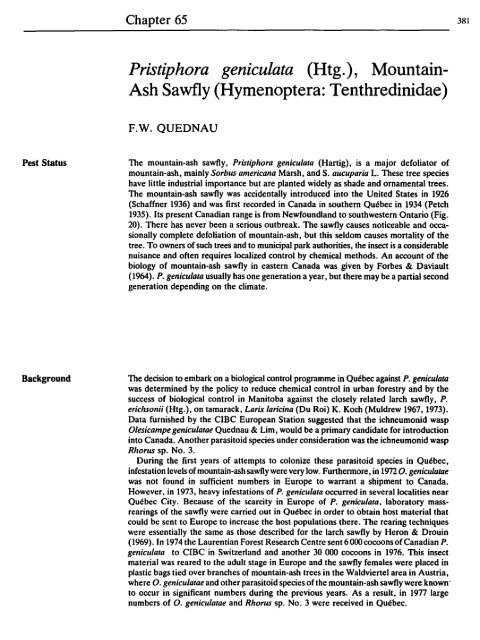pdf, 57.71Mb - Entomological Society of Canada
pdf, 57.71Mb - Entomological Society of Canada
pdf, 57.71Mb - Entomological Society of Canada
You also want an ePaper? Increase the reach of your titles
YUMPU automatically turns print PDFs into web optimized ePapers that Google loves.
Pest Status<br />
Background<br />
Chapter 65<br />
Pristiphora geniculata (Htg. ), Mountain<br />
Ash Sawfly (Hymenoptera: Tenthredinidae)<br />
F.W. QUEDNAU<br />
The mountain-ash sawfly, Pristiphora geniculata (Hartig), is a major defoliator <strong>of</strong><br />
mountain-ash, mainly Sorbus americana Marsh, and S. aucuparia L. These tree species<br />
have little industrial importance but are planted widely as shade and ornamental trees.<br />
The mountain-ash sawfly was accidentally introduced into the United States in 1926<br />
(Schaffner 1936) and was first recorded in <strong>Canada</strong> in southern Quebec in 1934 (Petch<br />
1935). Its present Canadian range is from Newfoundland to southwestern Ontario (Fig.<br />
20). There has never been a serious outbreak. The sawfly causes noticeable and occasionaJly<br />
complete defoliation <strong>of</strong> mountain-ash, but this seldom causes mortality <strong>of</strong> the<br />
tree. To owners <strong>of</strong> such trees and to municipal park authorities, the insect is a considerable<br />
nuisance and <strong>of</strong>ten requires localized control by chemical methods. An account <strong>of</strong> the<br />
biology <strong>of</strong> mountain-ash sawfly in eastern <strong>Canada</strong> was given by Forbes & Daviault<br />
(1964). P. geniculata usually has one generation a year, but there may be a partial second<br />
generation depending on the climate.<br />
The decision to embark on a biological control programme in Quebec against P. geniculata<br />
was determined by the policy to reduce chemical control in urban forestry and by the<br />
success <strong>of</strong> biological control in Manitoba against the closely related larch sawfly, P.<br />
erichsonii (Htg.), on tamarack, Larix laricina (Du Roi) K. Koch (Muldrew 1967, 1973).<br />
Data furnished by the CIBC European Station suggested that the ichneumonid wasp<br />
Olesicampe geniculatae Quednau & Lim, would be a primary candidate for introduction<br />
into <strong>Canada</strong>. Another parasitoid species under consideration was the ichneumonid wasp<br />
Rhorus sp. No.3.<br />
During the first years <strong>of</strong> attempts to colonize these parasitoid species in Quebec,<br />
infestation levels <strong>of</strong> mountain-ash sawfly were very low. Furthermore, in 1972 O. geniculatae<br />
was not found in sufficient numbers in Europe to warrant a shipment to <strong>Canada</strong>.<br />
However, in 1973, heavy infestations <strong>of</strong> P. geniculata occurred in several localities near<br />
Quebec City. Because <strong>of</strong> the scarcity in Europe <strong>of</strong> P. geniculata, laboratory massrearings<br />
<strong>of</strong> the sawfly were carried out in Quebec in order to obtain host material that<br />
could be sent to Europe to increase the host populations there. The rearing techniques<br />
were essentially the same as those described for the larch sawfly by Heron & Drouin<br />
(1969). In 1974 the Laurentian Forest Research Centre sent 6 000 cocoons <strong>of</strong> Canadian P.<br />
geniculata to CIBC in Switzerland and another 30 000 cocoons in 1976. This insect<br />
material was reared to the adult stage in Europe and the sawfly females were placed in<br />
plastic bags tied over branches <strong>of</strong> mountain-ash trees in the Waldviertel area in Austria,<br />
where O. geniculatae and other parasitoid species <strong>of</strong> the mountain-ash sawfly were known'<br />
to occur in significant numbers during the previous years. As a result, in 1977 large<br />
numbers <strong>of</strong> O. geniculatae and Rhorus sp. No.3 were received in Quebec.<br />
381
















